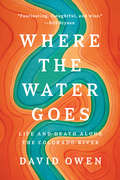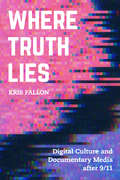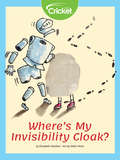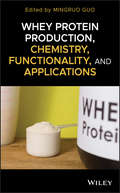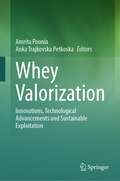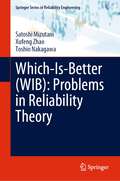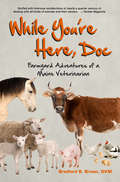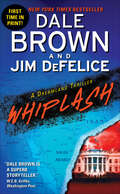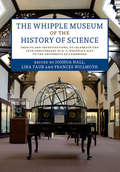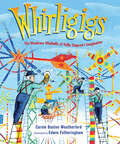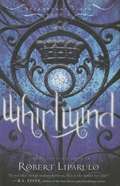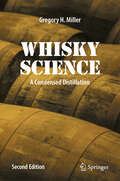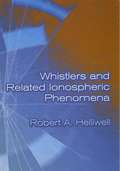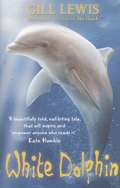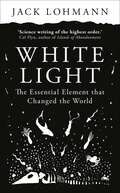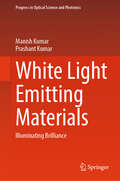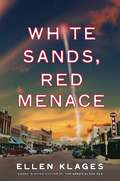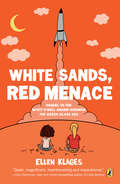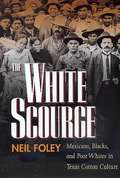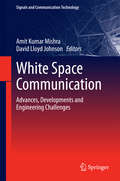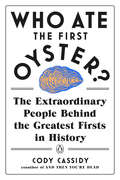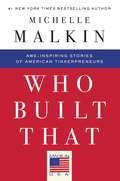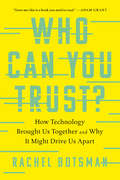- Table View
- List View
Where the Water Goes: Life and Death Along the Colorado River
by David OwenA brilliant, eye-opening account of where our water comes from and where it all goes <P> The Colorado River is a crucial resource for a surprisingly large part of the United States, and every gallon that flows down it is owned or claimed by someone. <P> David Owen traces all that water from the Colorado's headwaters to its parched terminus, once a verdant wetland but now a million-acre desert. <P>He takes readers on an adventure downriver, along a labyrinth of waterways, reservoirs, power plants, farms, fracking sites, ghost towns, and RV parks, to the spot near the U.S.–Mexico border where the river runs dry. <P>Water problems in the western United States can seem tantalizingly easy to solve: just turn off the fountains at the Bellagio, stop selling hay to China, ban golf, cut down the almond trees, and kill all the lawyers. <P>But a closer look reveals a vast man-made ecosystem that is far more complex and more interesting than the headlines let on. <P>The story Owen tells in Where the Water Goes is crucial to our future: how a patchwork of engineering marvels, byzantine legal agreements, aging infrastructure, and neighborly cooperation enables life to flourish in the desert, and the disastrous consequences we face when any part of this tenuous system fails.
Where Truth Lies: Digital Culture and Documentary Media after 9/11
by Kris FallonA free open access ebook is available upon publication. Learn more at www.luminosoa.org. This boldly original book traces the evolution of documentary film and photography as they migrated onto digital platforms during the first decades of the twenty-first century. Kris Fallon examines the emergence of several key media forms—social networking and crowdsourcing, video games and virtual environments, big data and data visualization—and demonstrates the formative influence of political conflict and the documentary film tradition on their evolution and cultural integration. Focusing on particular moments of political rupture, Fallon argues that the ideological rifts of the period inspired the adoption and adaptation of newly available technologies to encourage social mobilization and political action, a function performed for much of the previous century by independent documentary film. Positioning documentary film and digital media side by side in the political sphere, Fallon asserts that "truth" now lies in a new set of media forms and discursive practices that implicitly shape the documentation of everything from widespread cultural spectacles like wars and presidential elections to more invisible or isolated phenomena like the Abu Ghraib torture scandal or the "fake news" debates of 2016.
Where's My Invisibility Cloak?
by Elizabeth GardnerHave you ever wished you could have Harry Potter’s invisibility cloak? At some point soon, you just might be able to get one! Scientists are experimenting with a special material that bends light so the material is concealed. They still have a long way to go, but if they succeed, it could be one of the coolest inventions of the century!
Whey Protein Production, Chemistry, Functionality, and Applications
by Mingruo GuoAn up-to-date overview of the dynamic field of whey protein utilization Whey Protein Production, Chemistry, Functionality and Applications explores the science and technology behind the rapidly increasing popularity of this most versatile of dairy by-products. With its richly nutritious qualities, whey protein has been widely used in the food industry for many years. The last decade has, however, seen manufacturers develop many innovative and exciting new applications for it, both in food and other areas. Taking account of these advances, this insightful work offers a full explanation of the technological and chemical breakthroughs that have made whey protein more in-demand than ever before. Topics covered include manufacturing technologies, thermal and chemical modifications, non-food uses, denaturation and interactions, and more. In its broad scope, the book encompasses: An up-to-date overview of recent developments and new applications Breakdowns of the chemical, nutritional, and functional properties of whey protein Commentary on the current and future outlooks of the whey protein market Examinations of the methods and manufacturing technologies that enable whey protein recovery A full guide to the numerous applications of whey protein in food production and other industries Whey Protein Production, Chemistry, Functionality and Applications is an unparalleled source of information on this highly adaptable and much sought-after commodity, and is essential reading for food and dairy scientists, researchers and graduate students, and professionals working in the food formulation and dairy processing industries.
Whey Valorization: Innovations, Technological Advancements and Sustainable Exploitation
by Amrita Poonia Anka Trajkovska PetkoskaThis book focuses on the exploitation of whey through the extensive analysis of its molecular composition. Whey can provide various valuable compounds such as lactose, proteins and peptides. The book covers the biotechnological treatments of whey using biochemical and enzymatic treatment and microbial transformation, various high value products such as bioethanol, glycerol, Bioplastics (PLA), bacteriocins, exopolysaccharides, bacterial polysaccharides (PHA, PHB, Xanthan), single cell proteins, probiotics, bioactive peptides, organic acids (lactic, butyric, acetic acid), enzymes and biogas using microbial conversion of whey. The book also covers the use of whey for the preparation of different food products such as whey powder, condensed whey, spreads and various whey-based beverages including fermented beverages. Recent trends, opportunities and challenges in functional carbonated whey-based beverages are also discussed. Unlike the existing literature describing whey utilization, this book focuses on valorization, technological advancement and sustainable biotransformation of whey. The book also deals with membrane processing, sustainable approaches, biotechnological potential, green technologies and production of bioplastics. In addition, the book provides theoretical and practical information to present the various aspects of valorization of whey as a by-product. This book is a need of the hour for its eco-friendly approach. Whey Valorization: Innovations, Technological Advancements and Sustainable Exploitation will be a great resource for researchers, dairy technologists, food technologists, students and professionals working on sustainable and effective utilization of food as well as dairy wastes and by-products.
Which-Is-Better (Springer Series in Reliability Engineering)
by Satoshi Mizutani Xufeng Zhao Toshio NakagawaThis is the first book on the Which-Is-Better (WIB) Problem. These are questions that in daily life include such as “Which is larger, younger and stronger?". The main objective of this book is summarizing WIB Problems in maintenance and reliability theory. Optimal policies of replacement first, last and overtime are derived and compared theoretically and numerically, and WIB policies are determined. Furthermore, the reliability properties of parallel and standby systems are compared, and WIB system is determined. These WIB Problems are applied to shock and damage models and backup and checkpoint models of computer systems.
While You're Here, Doc: Farmyard Adventures of a Maine Veterinarian
by Bradford B. BrownVeterinarian Brad Brown never knew what to expect when he was called. Whether he was trying to geld a spooked stallion in a blizzard or found himself in the middle of an all-out fracas involving a monkey's abscessed tooth and a shotgun, he took it in stride, with great affection for both his four-legged patients and his two-legged clients.
Whiplash: Whiplash (Dreamland Thrillers #11)
by Dale Brown Jim DeFeliceA high-tech covert strike force takes aim at a nuclear armed extremist in the New York Times–bestselling co-author’s military techno-thriller.The world is watching as the U.S. and Iran agree to lay down their swords. But one man hiding in Africa holds the power to obliterate the peace. Shrouded by the bloody madness of tribal warfare, Iranian functionary-turned-fanatic Bani Aberhadji has created a vast network dedicated to unleashing a nuclear nightmare. Only by chance are American agents now learning of its existence . . . and it may already be too late.The covert strike force Whiplash is armed and ready to spring into action. Born from the ashes of Dreamland, it possesses the most cutting-edge military technology on Earth. But Aberhadji’s web of death is wide and well concealed . . . and the doomsday clock is ticking.
The Whipple Museum of the History of Science: Objects and Investigations, to Celebrate the 75th Anniversary of R. S. Whipples's Gift to the University of Cambridge
by Joshua Nall Liba Taub Frances Willmoth†In this book the diverse objects of the Whipple Museum of the History of Science's internationally renowned collection are brought into sharp relief by a number of highly regarded historians of science in fourteen essays. Each chapter focuses on a specific instrument or group of objects, ranging from an English medieval astrolabe to a modern agricultural 'seed source indicator' to a curious collection of plaster chicken heads. The contributors employ a range of historiographical and methodological approaches to demonstrate the various ways in which the material culture of science can be researched and understood. The essays show how the study of scientific objects - including instruments and models - offers a window into cultures of scientific practice not afforded by textual sources alone. This title is also available as Open Access on Cambridge Core.
Whirligigs: The Wondrous Windmills of Vollis Simpson's Imagination
by Carole Boston WeatherfordTake a journey through the creative process that led folk artist Vollis Simpson to create his wonderful and whimsical wind-powered whirligigs and more in this STEAM/STEM picture book.Vollis Simpson was a man with a curious mind—always eager to know how things worked and how to fix them. Growing up on a farm in North Carolina, he loved to tinker with machines. And when he served in the Army Air Corps during WWII, Vollis kept right on tinkering. His ingenuity allowed him to build things no one would have thought to create from scraps—a washing machine out of airplane parts and a motorcycle out of a bike. After the war, his passion for metal creations picked up speed—turning into a whirlwind of windmills as far as the eye could see. Luckily, Vollis&’s fanciful and colorful windmills have been preserved at a park in Wilson, NC, where visitors can behold his magnificent and towering creations forever whizzing in the air.
Whirlwind (Dreamhouse Kings #5)
by Robert LiparuloDavid, Xander, and Toria King never know where the mysterious portals in their house will take them: past, present, or future. They've still got to find a way to bring their mother back and keep Taskidian from getting them out of the house.
Whisky Science: A Condensed Distillation
by Gregory H. MillerTo be updated with second edition.This is a book about the science behind whisky: its production, its measurement, and its flavor. The main purpose of this book is to review the current state of whisky science in the open literature. The focus is principally on chemistry, which describes molecular structures and their interactions, and chemical engineering which is concerned with realizing chemical processes on an industrial scale. Biochemistry, the branch of chemistry concerned with living things, helps to understand the role of grains, yeast, bacteria, and oak. Thermodynamics, common to chemistry and chemical engineering, describes the energetics of transformation and the state that substances assume when in equilibrium. This book contains a taste of flavor chemistry and of sensory science, which connect the chemistry of a food or beverage to the flavor and pleasure experienced by a consumer. There is also a dusting of history, a social science.
Whistlers and Related Ionospheric Phenomena
by Robert A. HelliwellThe investigation of whistlers and related phenomena is a key element in studies of very-low-frequency propagation, satellite communication, the outer ionosphere, and solar-terrestrial relationships. This comprehensive text presents a history of the study of the phenomena and includes all the elements necessary for the calculation of the characteristics of whistlers and whistler-mode signals.An introduction and brief history are followed by a summary of the theory of whistlers and a detailed explanation of the calculation of their characteristics. Succeeding chapters offer a complete atlas of a variety of whistlers, including those observed in satellites and those generated by nuclear explosions; the results of satellite observation of whistler-mode propagation; the method of reducing whistler data and obtaining electron density information; a full atlas of the various kinds of emissions; and an outline and comparison of the theories of generation of emissions.
White Dolphin
by Gill Lewis"The white dolphin is a sign that Mum's out there ..." When they first meet, Kara and Felix can't stand each other. But on discovering an injured dolphin calf on the beach they know they must work together to save it. Now friends, they set out to find the truth behind the disappearance of Kara's mother, and to protect the nearby reef. But powerful people don't want them to succeed. And with the odds stacked against them, how can Kara and Felix make their voices heard?
The White House Tapes: Eavesdropping on the President
by John PradosTranscripts of tape recordings beginning with Roosevelt.
White Light: The Essential Element that Changed the World
by Jack Lohmann&‘White Light is a conscience-driven tour de force.' Pico Iyer The most important element you never think about – uncover the secret life of phosphorus Phosphorus is the keystone of life. Without it, cells cannot divide and plants cannot photosynthesise. Highly reactive, it is seldom found in its elemental form – but, when pure white phosphorus is exposed to air, it emits a ghostly white light. In 1842, Darwin&’s beloved botany professor, Reverend John Stevens Henslow, discovered the miraculous potential of phosphorus as a fertilizer. He hardly imagined that his countrymen would soon be grinding the bones of dead soldiers and mummified Egyptian cats to fertilise farms. Nor that his discovery would spawn a global mining industry, changing diets, lifestyle and the face of the planet forever. Journeying across the flat expanses of Henslow&’s Suffolk to far-flung Nauru, an island stripped of its life force by this ravenous young industry, Lohmann sifts through the Earth&’s geological layers and eras, exploring our strained relationship with a life-giving element. Bold, lyrical, genre-defying, White Light invites us to renew our broken relationship not just with the earth but with our own death – and the life it brings after us. *** 'An effervescent – or I should say phosphorescent – debut from a talented young science writer.' Steve Brusatte, bestselling author of The Rise and Fall of the Dinosaurs 'An eerie exploration of a strange and surprising element, and a plangent warning of a looming environmental crisis that needs our attention. Science writing of the highest order.' Cal Flyn, author of Islands of Abandonment 'In this deft and radiant book, Jack Lohmann has achieved something quite rare: a work that is scientifically precise yet ethically expansive.' Rob Nixon, author of Slow Violence
White Light Emitting Materials: Illuminating Brilliance (Progress in Optical Science and Photonics #31)
by Manish Kumar Prashant KumarThis book offers an in-depth exploration of the rapidly evolving field of luminescent materials that hold the key to energy-efficient lighting and advanced display technologies. This book delves into the synthesis, characterization, and application of white light-emitting materials, ranging from organic and inorganic compounds to cutting-edge nanomaterials like quantum dots and carbon-based nanostructures. Through comprehensive discussions on the underlying photophysical mechanisms and emission properties, this volume provides valuable insights into the science driving innovation in solid-state lighting and optoelectronics. This book delivers essential knowledge on how these materials are shaping the future of sustainable and high-performance lighting, providing a good read for researchers, materials scientists, or industry professionals.
White Sands, Red Menace
by Ellen KlagesIt is 1946, and the events of The Green Glass Seahave changed the world and Dewey Kerrigan's life. She's now living near the White Sands Missile Range in New Mexico with the Gordon family. Dr. Gordon is working on rockets that will someday go to the moon; Mrs. Gordon is working on stopping the Bomb. Meanwhile, Dewey and her sister, Suze, share secrets, art, and science as they adjust to high school in an isolated desert town. Then, like a different kind of dropped bomb, Dewey's long-lost mother, Rita Gallucci, reappears in their lives. And she wants to take her daughter away.
White Sands, Red Menace (The Gordon Family Saga #2)
by Ellen KlagesIt is 1946. World War II is over?ended by the atomic bomb that Dewey Kerrigan?s and Suze Gordon?s scientist parents helped build. Dewey?s been living with the Gordons since before the war?s end, before her father died, moving south with them to Alamogordo, New Mexico. At the White Sands Missile Range, Phil Gordon is working on rockets that will someday go to the moon; at home, Terry Gordon is part of the scientists? movement against the Bomb. Dewey and Suze have conflicts of their own. Where does a girl who likes physics and math fit in? How do you know the right time to speak up and the right time to keep your head down? And, most important of all: What defines a family?
The White Scourge: Mexicans, Blacks, and Poor Whites in the Cotton Culture
by Neil FoleyA powerful, award-winning work of social history about race, class and labor in Texas from post-civil war to the Depression.
White Space Communication
by Amit Kumar Mishra David Lloyd JohnsonThis monograph presents a collection of major developments leading toward the implementation of white space technology - an emerging wireless standard for using wireless spectrum in locations where it is unused by licensed users. Some of the key research areas in the field are covered. These include emerging standards, technical insights from early pilots and simulations, software defined radio platforms, geo-location spectrum databases and current white space spectrum usage in India and South Africa.
White Space Communication Technologies
by Nuno Borges Carvalho Alessandro Cidronali Roberto Gómez-GarcíaIncrease the efficient use of time-varying available spectrum with this unique book, the first to describe RF hardware design for white space applications, including both analog and digital approaches. Emerging technologies are discussed and signal processing issues are addressed, providing the background knowledge and practical tools needed to develop future radio technologies. Real-world examples are included, together with global spectrum regulations and policies, for a practical approach to developing technologies for worldwide applications. Cross analog and digital design guidelines are provided to help cut design time and cost. This holistic, system level view of transceiver design for white space technologies is ideal for practising engineers and students and researchers in academia.
Who Ate the First Oyster?: The Extraordinary People Behind the Greatest Firsts in History
by Cody CassidyWho wore the first pants? Who painted the first masterpiece? Who first rode the horse? Who invented soap? This madcap adventure across ancient history uses everything from modern genetics to archaeology to uncover the geniuses behind these and other world-changing innovations.Who invented the wheel? Who told the first joke? Who drank the first beer? Who was the murderer in the first murder mystery, who was the first surgeon, who sparked the first fire--and most critically, who was the first to brave the slimy, pale oyster?In this book, writer Cody Cassidy digs deep into the latest research to uncover the untold stories of some of these incredible innovators (or participants in lucky accidents). With a sharp sense of humor and boundless enthusiasm for the wonders of our ancient ancestors, Who Ate the First Oyster? profiles the perpetrators of the greatest firsts and catastrophes of prehistory, using the lives of individuals to provide a glimpse into ancient cultures, show how and why these critical developments occurred, and educate us on a period of time that until recently we've known almost nothing about.
Who Built That: Awe-Inspiring Stories of American Tinkerpreneurs
by Michelle Malkin<p>Firebrand conservative columnist, commentator, Internet entrepreneur, and #1 <i>New York Times</i> bestselling author Michelle Malkin tells the fascinating, little-known stories of the inventors who have contributed to American exceptionalism and technological progress. <p>In July 2012, President Obama infamously proclaimed: "If you've got a business--you didn't build that. Somebody else made that happen". Malkin wholeheartedly disagrees. <i>Who Built That</i> is a rousing tribute to the hidden American capitalists who pioneered everyday inventions. They're the little big things we take for granted: bottle caps and glassware, tissue paper, flashlights, railroad signals, bridge cables, revolutionary plastics, and more. <p>Malkin takes readers on an eclectic journey of American capitalism, from the colonial period to the Industrial Age to the present, spotlighting awe-inspiring and little-known "tinkerpreneurs" who achieved their dreams of doing well by doing good.</p> <p>You'll learn how famous patent holders Abraham Lincoln and Mark Twain championed the nation's unique system of intellectual property rights; how glass manufacturing mavericks Edward Libbey and Mike Owens defied naysayers to revolutionize food, beverage, and pharmaceutical packaging; how penniless Croatian immigrant Anthony Maglica started his $400 million Maglite flashlight business in a rented garage; and many more riveting stories that explain our country's fertile climate for scientific advancement and entrepreneurship. <p>To understand who we are as people, we need to first understand what motivates America's ordinary and extraordinary makers and risk-takers. Driven by her own experience as a second-generation beneficiary of the American Dream, Malkin skillfully and passionately rebuts collectivist orthodoxy to celebrate the engineers, mechanics, designers, artisans, and relentless tinkerers of all backgrounds who embody our nation's spirit of self-made entrepreneurialism.</p>
Who Can You Trust?: How Technology Brought Us Together and Why It Might Drive Us Apart
by Rachel BotsmanIf you can't trust those in charge, who can you trust?From government to business, banks to media, trust in institutions is at an all-time low. But this isn't the age of distrust--far from it.In this revolutionary book, world-renowned trust expert Rachel Botsman reveals that we are at the tipping point of one of the biggest social transformations in human history--with fundamental consequences for everyone. A new world order is emerging: we might have lost faith in institutions and leaders, but millions of people rent their homes to total strangers, exchange digital currencies, or find themselves trusting a bot. This is the age of "distributed trust," a paradigm shift driven by innovative technologies that are rewriting the rules of an all-too-human relationship.If we are to benefit from this radical shift, we must understand the mechanics of how trust is built, managed, lost, and repaired in the digital age. In the first book to explain this new world, Botsman provides a detailed map of this uncharted landscape--and explores what's next for humanity.
